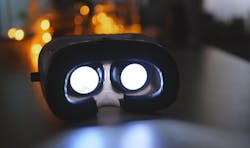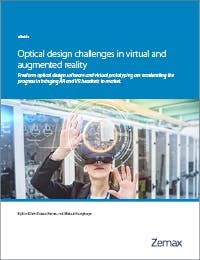Cutting-edge optical components enable thinner, lighter virtual reality systems
The delivery of augmented reality (AR), virtual reality (VR), and mixed reality (MR) systems requires cutting-edge optical technology—technology that could help AR/VR/MR headsets get smaller and smaller in the coming years. With augmented and virtual reality market projections reaching $108 B by 2021, the growth in the industry will be fueled in part by improvements in the tools that provide virtual prototyping of AR/VR/MR systems. Virtual prototyping can help companies get these hardware components to market faster—and smaller.
Wide applications of AR/VR/MR
There are a plethora of applications for AR/VR/MR beyond gaming, including aerospace, defense, education and training, industrial, healthcare, and many other fields. And developers who worked in the early stages of augmented reality intended it that way. Steve Mann, known for his pioneering work in the creation of the MIT Wearable Computing Lab, was among the first to create technologies meant for everyday use across vertical markets. One example is his EyeTap Digital Eye Glass, a general-purpose seeing aid that could have great use in any field where the user would benefit from real-time interactive information that is largely visual in nature—including sports, construction, and business.
Now, headlines tout AR/VR/MR innovations that enable business people to see a computer screen that isn’t really there with AR glasses for privacy and productivity; transport students on a field trip without ever leaving the classroom, or train employees on features of new products.
The demand for smaller AR/VR/MR devices
As Scott McEldowney of Oculus Research explained, creating light, “go-anywhere” glasses to replace the awkward VR goggles of today is instrumental for the future of augmented, virtual, and mixed reality. While that leap will require technology that doesn’t exist today, said McEldowney, he pointed out that now-commonplace utilities such as Facebook and Uber would once have been equally unimaginable.
Companies delivering headsets that enable VR/MR experiences know that getting there means that display technologies are key. These include both head-mounted displays (HMDs) and head-up displays (HUDs). Engineers will need to combine nanoscale optical components used to create computer-generated images with macroscopic optics used to relay images to the human eye.
Virtual prototyping and AR/VR/MR
Companies designing these types of AR/VR/MR products are under increased pressure to optimize optical system performance, reduce costs, and shorten time to market. To get to a high-confidence design more quickly, companies are using Zemax Virtual Prototyping to enable engineers to simulate how light travels through the complete optomechanical system design—before building a physical prototype. By using OpticStudio and LensMechanix together, optical and mechanical engineers can share complete design data and ensure the quality of the optical performance throughout the entire design cycle.
New guide: How to overcome optical design challenges in VR and AR
Companies designing these types of AR/VR/MR products are under increased pressure to optimize optical system performance, reduce costs, and shorten time to market. Read our in-depth article on how freeform-optics design software and virtual prototyping are helping teams get to a high-confidence design more quickly.
Learn:
· The unique challenges associated with designing for VR and AR
· How to design smaller and lighter headsets
· What to look for in optical design software packages for designers working on these systems

